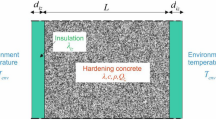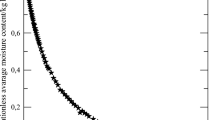Abstract
The purpose of this study was to investigate the response of saturated water vapour steaming on boards from Scots pine and Norway spruce. Steaming treatment of the predried boards were done in a laboratory chamber equipped with a 1.5 kW electric water boiler. The experiments were performed mainly at 100°C in saturated steam and the relation between temperature and moisture pickup as well as stress relaxation was studied. The results showed that steaming is a very efficient process to relax stress and equalise moisture gradients in boards. The gain of time is considerable; steaming takes only about 10% of traditional conditioning time at lower temperatures. The temperature rise is correlated to moisture pickup from surface condensation resulting in the possibility of estimating the increase of moisture content during steaming from measurements of temperature.
Zusammenfassung
Ziel dieser Studie war es zu untersuchen, welche Reaktionen gesättigter Wasserdampf an Brettern von schottischer Kiefer und norwegischer Fichte hervorruft. Behandlungen der zuvor getrockneten Bretter wurden in einer Laborkammer durchgeführt, die mit einem 1,5kW elektrischen Wasserkocher ausgestatet war. Die Versuche wurden überwiegend bei einer Tempertur von 100°C ausgeführt. Die Beziehung zwischen Temperatur und Feuchteaufnahme sowie die Spannungsminderung wurden untersucht. Die Ergebnisse zeigten, daß Dämpfung eine sehr wirkungsvolle Behandlung ist, um innere Spannungen aufzuheben und die Feuchte der Bretter auszugleichen. Der Zeitgewinn ist groß. Bei niedrigen Temperaturen erfordert die Dämpfungsmethode nur rund 10% der konventionellen Befeuchtungszeit. Die Temperaturerhöhung ist korreliert mit der Feuchteaufnahme aufgrund der Oberflächenkondensation. Dies ermöglicht es, den Feuchteverlauf während der Dämpfung anhand der Temperaturerhöhung zu berechnen.
Similar content being viewed by others
References
Avramidis, S.; Dubois, Joël 1992: Sorption Energies of Some Canadian Species. Holzforschung 46(2):177–179.
Dubois, J. et al. 1992: The influence of conditioning on honeycomb development in high-temperature-dried Pacific Coast hemlock. Forst Prod. J. 42(7/8):31–36.
Hart, A. C. 1990: Kiln overheat when conditioning lumber. Forest Prod. J. 40(4):9–14
Haslett, A. N.; Simpson, I. G. 1992: Steam conditioning after high temperature drying. Third IUFRO International Wood Drying Conference, BOKU, Vienna, Austria. 196–204.
Kollman, F. 1982: Holz und Wärme. Holz-Zentralblatt 108(144):2074–2077
Morén, T. 1993: Creep Response to Drying of Timber Boards of Scots Pine. Submitted for publication. Forest Prod. J.
Skaar, C. Wood-Water Relation 1988. Wood-Water Relations. Springer-Verlag Berlin.
Tokumoto, M. 1989: Casehardening and Drying Set in the Kiln-Drying of Wood I. Creep and set of wood during kiln-drying. Journal of the Japan Wood Research Society, No. 35, No. 3:175–184
Williams, D. H. 1981: Internal checking in New Zealand-grown Radiata Pine after high temperature dyring. New Zealand Journal of Forestry Science 11(1): 60–64
Visser, J. J.; Vermaas H. F. 1988: Steaming under Restraint to Remove Twist in Previously Dried Pinus radiata Boards. Holzforschung. 42(1):59–63.
Author information
Authors and Affiliations
Rights and permissions
About this article
Cite this article
Morén, T. Steam conditioning after low temperature dyring. Holz als Roh-und Werkstoff 52, 77–82 (1994). https://doi.org/10.1007/BF02615468
Issue Date:
DOI: https://doi.org/10.1007/BF02615468




